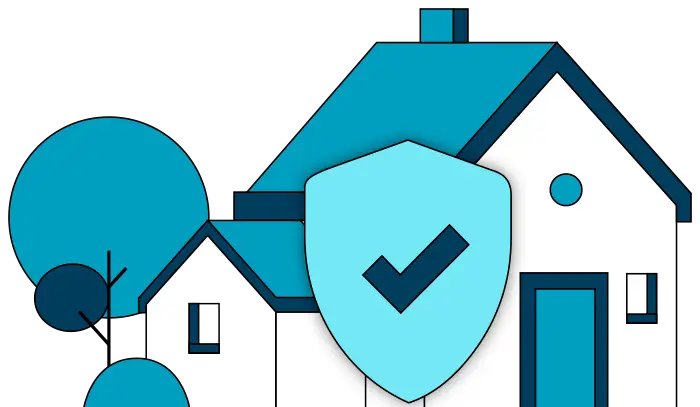Your home insurance will protect you from the costs associated with sudden damage to your home and possessions. Insurance policies will cover many different perils and coverages, but what about your pipes? Winter weather around the nation may have some of you wondering if your homeowners insurance will cover burst pipes. In colder areas, pipes are more liable to burst under frozen conditions. Will your home insurance cover your burst pipes?
In short, yes, your homeowners insurance will cover the damage caused by your burst pipes. This could include water damage incurred on your floors, furniture, walls, windows, or doors, for example. You may even be covered if your burst pipes cause you to move or pay more for living expenses temporarily.

Of course, these policy perks come with a few drawbacks. In some cases, your insurance may not approve your claim for burst pipes. Keep reading to discover these exclusions, and learn more about how your insurance will protect you.
When burst pipes are not covered by home insurance
Your homeowner’s insurance is designed to take care of abrupt and unexpected events. As such, proving that your pipes burst because of an accident may become troublesome. There are a few common issues and damages that won’t be covered by your insurance policy:
Negligence & intent
Homeowner’s insurance will not cover a burst pipe in the event of neglect. This means if you leave your plumbing in disrepair, your burst pipes may not be considered a “sudden” event.
The same can be said for intentional damage done to your pipes. If it becomes obvious that you caused damage to your pipes, your insurance will not foot the bill. Negligence and intent are never covered under any policy.
Flood or earth movement
Flooding and the movement of the earth are two perils that are not listed on a standard policy. An earthquake, landslide, or sinkhole can easily sever a pipe, and flooding can cause corrosive damage to your systems.
Still, in order for your pipes to be covered as the result of a flood or earth movement, you need to add these endorsements to your policy. Only then will your insurance cover a burst pipe and the damage that follows.
Water Backups
When water or sewage backs up into your pipes and it bursts, the damages will not be covered by a standard insurance policy. These kinds of backups can be caused by many reasons.
When a pipe system becomes clogged, the water pressure buildup can cause a pipe to burst. The same thing happens when a tree root applies too much pressure on a pipe. In this case, the damage caused will not be covered. Much like flood or earth movement insurance, you will need an endorsement on your policy to take care of this type of damage.
Improper installation
It’s very important to always have work or plumbing completed by licensed professionals. In the case where your pipes were placed improperly by an unlicensed contractor, your insurance company may deny your claim.
This kind of damage could be viewed as poor maintenance on your part by an insurance company. As a result, they may not be so quick to pay for the damages.

Does home insurance cover frozen pipes?
There are several different policies created to fully encompass your home with protection. HO-1 through HO-8 each outline different perils they cover and to what extent. HO-1 is a policy that is so standard, it typically won’t cover a frozen pipe.
HO-1 is called the Basic Form. Conveniently enough, it only covers the most basic perils. These risks mock the 10 perils listed on your dwelling coverage, which does not include freezing or accidental overflow of plumbing. Other policies will include freezing damage, though, so watch out for those terminologies.
Furthermore, it will only protect your dwelling and other structures from these damages. Sometimes your personal property will be covered by these as well. Nevertheless, it just isn’t enough coverage to protect you from the costs accumulated by a burst pipe. We’ll talk about what policies and coverages you need to have in just a moment.
Policies that address water damage from burst pipes
We’ve already discussed why it may be difficult to have your claim approved under an HO-1 policy. It might help to take a closer look at your policy and coverage details to understand just how covered you are. Your burst pipes can be covered under a few different policies.
HO-2
An HO-2 covers all the perils listed on your HO-1, which, as we know, isn’t enough. The bright side is, there are 6 other perils listed on an HO-2 which include the damage possible by a burst pipe. These are the accidental plumbing overflow and freezing perils.
Plus, an HO-2 covers your personal property whereas an HO-1 might not. In this case, the cost of your furniture and clothing will be reimbursed if a burst pipe ruined them.
HO-3 and HO-5
An HO-3 covers all of the perils from HO-1, HO2, and any other perils not named. That means your burst pipe can be covered regardless of what caused the damage. HO-3 will take care of the damage to your dwelling and other structures due to a burst pipe.
Your personal belongings will also be covered. HO-3 covers personal property on a named-peril basis, but burst pipes are among the perils that are covered. An HO-5 will cover the damage caused to your dwelling, other structures, and your personal property regardless of the named perils on your policy. Of course, all of these inclusions still don’t involve earthquakes, floods, sinkholes, or mudslides.
HO-4 & HO-6
These policies are for renters and co-op tenants. They each involve several coverages, including coverage for your personal property, loss of use, medical costs, and sometimes liability.
Co-op and condo policies will usually take care of the damage caused to your dwelling. This includes the ceiling, floors, and walls of your home.
HO-7
An HO-7 policy outlines coverage for mobile or modular homes. These include the same coverage as an HO-3. As such, a burst pipe in your manufactured home or trailer will be covered in the event of an accident.
HO–8
An HO-8 policy is designed to cover the costs of damage incurred on older, higher-risk homes. It includes the same coverage as an HO-3, but the payout might be much cheaper.
How different coverages protect from burst pipe damage
Damages from burst pipes and pipe leaks are some types of plumbing damages that can be covered by the standard homeowners insurance policy. Here are three common clauses in homeowners insurance policies that can help you fully understand the specific types of damages your home insurance can cover:
1. Property coverage C
This means your homeowners insurance will provide coverage for damaged personal property. Personal properties include appliances, furniture, clothing, and jewelry. Do take note that when it comes to jewelry, your insurer will only reimburse you up to your limits.
2. Dwelling coverage A
The dwelling coverage states that your home insurance will cover the costs of repairing damaged structures like walls and floorboards in your home.
3. ALE coverage D
ALE stands for “Additional Living Expenses.” Additional Living Expense coverage refers to reimbursements for food, lodging, and clothing expenses if you need to find accommodation while your home is uninhabitable due to repairs.
How do insurers assess burst pipe damage?
The key to finding out whether the plumbing damage in your home will be covered by your insurer or not is knowing how the insurance adjuster will assess the burst pipes or pipe leaks in your home.
You see, even though homeowners insurance usually covers damages caused by burst pipes or pipe leaks, there are still certain scenarios that can cause your insurance claim to get rejected. Insurance adjusters usually look for evidence that can tell them whether you could have prevented the damage or not. If they prove that the damage could have been prevented, your insurance claim may get rejected.
Some things the insurance adjuster will investigate include:
- Where the pipes are located
- Other sources of plumbing damage
- The age of the damage (If it’s new or old)
- Signs of wear and tear like rust
Additional endorsements and coverages
There are certain endorsements you can look out for in case your area is prone to freezing or burst pipes. Some of these endorsements may be worth adding to your policy to ensure you get the most coverage possible.
Sewer/Water or sump pump backup
While your policy may cover water damage due to a burst pipe, it will not cover water backed up through sewers. If your pipe breaks due to a sewage or sump pump backup, this endorsement would come in handy.
A sewer backup endorsement directly covers damage to the sewer line running from the city to your house. If you have this additional coverage, your dwelling, other structures, and personal property will be covered in the event of standing sewage caused by a burst pipe.
This still does not include damage caused by negligence, lack of maintenance, or general wear and tear. It also still doesn’t include repairs or replacement of a sump pump.
Equipment breakdown coverage
In case the burst pipe in your home is part of an appliance or system, equipment breakdown coverage can help. This endorsement covers damages to your broken appliances and electronics, which isn’t normally covered by a standard policy.
The covered equipment under this addition includes:
- Ovens
- Refrigerators
- Computers
- HVAC systems
- Sump pumps
- Electric panels
- Backup generators
- Water heaters
- Washers and dryers
- Gym equipment
When any of these items are destroyed by burst pipe water, they can be replaced or repaired under this endorsement. As always, this doesn’t include burst pipes as a result of neglect, wear and tear, or intent.
Earth movement coverage
The movement of the earth is a peril that you will not find on a standard insurance policy. Luckily, an earth movement insurance addition will cover your burst pipe in case of an earthquake or landslide.

Tips for getting your burst pipe insurance claim approved
Now that you’re familiar with how insurance adjusters investigate plumbing damages and what types of damages are and aren’t covered by homeowners insurance policies, here are a few tips to take note of to increase the chances of having your insurance claim approved.
1. Perform regular maintenance
Performing regular maintenance checks is one thing you can do to ensure a payout for a claim. Remember, when it comes to house damages, insurance adjusters check whether the damage is old or new. If you always perform maintenance checks, you would be less likely to end up with an old plumbing issue.
2. Keep things clean
Try to perform general cleaning once or twice a month in your basement, laundry room, garage, cabinets under sinks, and crawl spaces. Doing so will help you avoid mold problems that may not be covered by your home insurance.
3. Report damages immediately
Do not wait to file a report once you find plumbing damage in your home. The longer you wait to report the damages, the smaller your chances of getting your insurance claim approved will be.
4. Consult a contractor
If you’re unsure as to what caused the plumbing damage in your home or if you simply want to know how much your house repairs will cost, the best thing you can do is consult a contractor. Contractors can help you find out the root cause of your plumbing issues and they can help validate the insurance adjuster’s assessment.
Pipe leaks and burst pipes can do serious damage to a house if left unattended. But with repair costs averaging at $900, a lot of people can end up prolonging the damage because they still need to manage their resources to accommodate such an expense. Fortunately, typical homeowners insurance can provide some financial coverage for such repairs.
Conclusion
As a homeowner, it’s necessary to keep your home properly maintained. Doing so just might save you a world of stress.
Check your plumbing and pipes regularly to make sure you don’t have to foot the bill for a burst pipe. This includes regular inspections of appliances with water sources. For example, you need to drain your water heater every once in a while to prevent your pipes from deteriorating.
Additionally, you should know when to check your pipes for freezing. Keeping your pipes above the freezing point can keep them working properly and prevent a sudden burst. Sometimes this can be as simple as keeping the water running or insulating your pipes during cold weather.
Once you’ve guaranteed that the pipes in your home are in good standing, your insurance will take care of the rest. It’s always helpful to look at possible endorsements on your policy to get the most out of your homeowner’s insurance.

